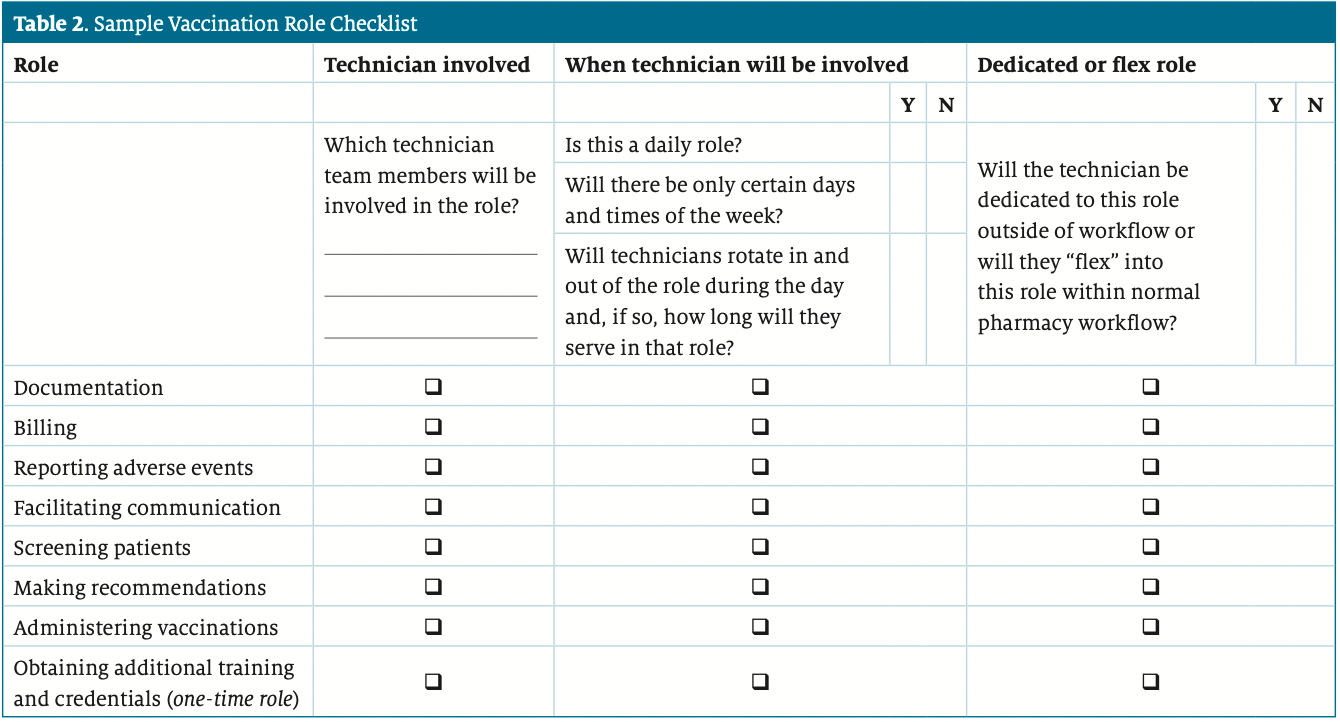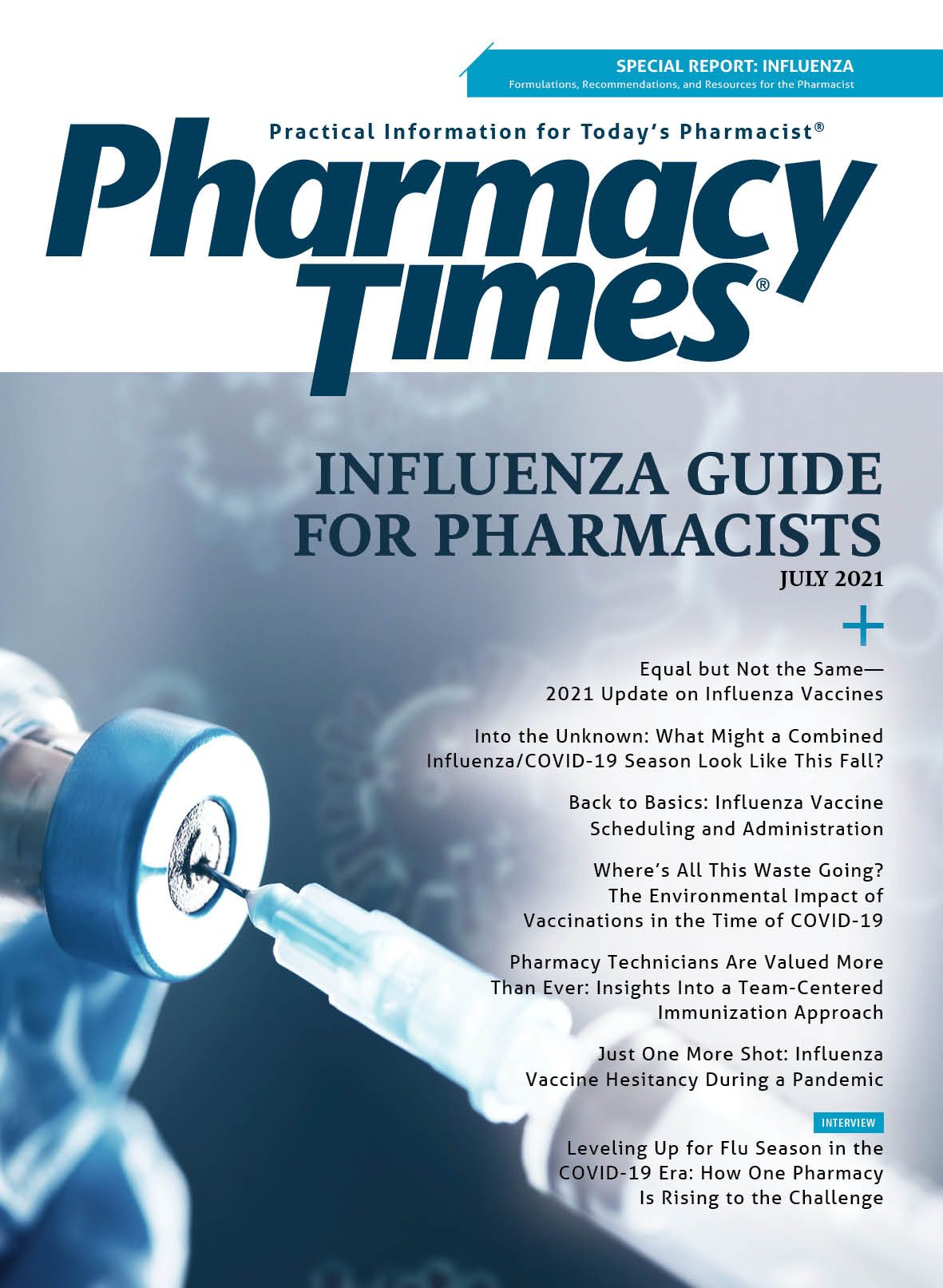Publication
Article
Supplements
Pharmacy Technicians Are Valued More Than Ever: Insights Into a Team-Centered Immunization Approach
Author(s):
Since the advent of the global COVID-19 pandemic, the health care community has experienced an increased demand on services. In the United States, the health care system continues to be pushed to its breaking point with rising workload demands on health care providers. These demands include preparing for the implementation of pandemic-related services and delivering those services (eg, point-of-care testing, vaccinations, increased inpatient census, triaging of care).1
As essential businesses on the front lines, pharmacies have continued to demonstrate their value during the pandemic by remaining open to the community for vital prescription services, evolving into COVID-19 point-of-care testing sites, and becoming COVID-19 vaccine administration sites. Pharmacies are essential in achieving the end goal of herd immunity2 in the global battle against SARS-CoV-2, the virus that causes COVID-19.
Now pharmacies will have the opportunity to take the lessons learned during the COVID-19 vaccination rollout to prepare for the 2021-2022 influenza season.3 On February 26, 2021, the World Health Organization released the recommendations for the 2021-2022 Northern Hemisphere seasonal influenza vaccine.4 (Also see Equal But Not the Same—2021 Update on Influenza Vaccines on page 6).
With many people remaining to be vaccinated against COVID-19 and everyone 6 months and older needing an annual influenza vaccine for the 2021-2022 season, many pharmacies are turning to pharmacy technicians to assist in the process.5,6
Federal Vs State Regulation: Advances in the Pharmacy Technician's Ability to Vaccinate
Historically, the role of pharmacy technicians in administering vaccinations has been primarily administrative, devoted to tasks such as billing and documentation.7 Due to state-specific scope-of-practice rules and regulations, the technicians’ role has traditionally been limited to assisting pharmacists, rather than physically administering vaccines. However, this changed in 2017, when Idaho became the first state to allow pharmacy technicians to administer vaccinations as part of a statewide initiative toward “relieving the burden that pharmacists typically carry.” Since that time, pharmacy technicians have administered over 25,000 vaccinations in Idaho. Michigan, Washington, Rhode Island, Utah, and Nevada have since followed suit and have granted approval for pharmacy technicians to administer vaccinations.8
On August 19, 2020, the Department of Health and Human Services issued an amendment to the Public Readiness and Emergency Preparedness (PREP) Act, allowing pharmacy technicians to administer immunizations in all US states, regardless of state-specific rules, as long as specific requirements are met (see Table 1).9
Technicians interested in learning how to administer immunizations can access an accredited technician-specific training from the National Healthcareer Association,10 the American Pharmacists Association (APhA),11 the American Society of Health-System Pharmacists,12 or the Coalition for the Advancement of Pharmacy Technician Practice.13 They can also peruse the Pharmacy Technician Certification Board directory for training programs on immunization administration from other organizations.14 Additionally, information on advanced accreditation for pharmacists and pharmacy technicians in the PREP Act, which states where laws allow for the vaccination of children as young as 3 years, is also available from APhA.15
The federal government, states, territories, and 21 national pharmacy partners and independent pharmacy networks also are coming together to form the Federal Retail Pharmacy Program for COVID-19 Vaccination. This program will increase patients’ access to the vaccines16 through pharmacists as the most trained and accessible health care providers.
ACIP, Advisory Committee on Immunization Practices; ACPE, Accreditation Council for Pharmacy Education; PREP, Public Readiness and Emergency Preparedness.

Additional Ways Pharmacy Technicians Will Assist In Vaccination Efforts
Pharmacy technicians are critical team members who facilitate a variety of pharmacy services. Just as they perform many roles in the medication-dispensing workflow process, they will assume multiple roles in the delivery of clinical services such as immunizations.
Whereas clinical service delivery roles include actual delivery of a service (eg, administering vaccinations), clinical support roles include helping with a clinical service (eg, documentation and billing) but do not include performing the service itself. Technician involvement in clinical service delivery and support roles are vital elements for the sustainability of the services.
The results of a 2011 scoping review article identified the following clinical service support roles for pharmacy-based vaccination programs7:
- Documentation
- Billing
- Reporting adverse events
- Facilitating communication
- Obtaining training and certification
Since that time, pharmacy technicians also have become increasingly involved in screening for vaccine eligibility, making vaccination recommendations, and administering vaccinations under the supervision of a pharmacist.17,18
Which role and to what extent it is served will vary from pharmacy to pharmacy. An open dialogue between the entire pharmacy team surrounding each of these roles will be key to successful vaccine implementation. (A sample vaccination role checklist is provided in Table 2.)
Questions a pharmacy team should consider when contemplating expanding the role of pharmacy technicians include the following:
- What roles will technicians serve at this pharmacy?19
- Which technicians will serve those roles?
- What training or credentials will they need to serve in this role?19
- How often and when will technicians serve in these roles?
- Will they be dedicated to this role or flex (move in and out of the role) within normal pharmacy workflow?
It is also critical to gauge technicians’ willingness to expand their role within a pharmacy as comfortability with advanced pharmacy technician roles varies.20 Notably, comfortability increases with increased training and experience. Therefore, if a technician is motivated to serve in one of these new roles but feels uncomfortable, a pharmacy may find that providing additional training, shadowing, and hands-on experience may improve technician willingness to take on additional responsibilities beyond their comfort zone.19-21

Conclusions
Overall, the COVID-19 pandemic has taken a major toll on the US health care system by significantly increasing the workload
demands on health care providers. These heightened demands include preparation for pandemic-related services and the resultant delivery of those services. Although many individuals have been asked to remain at home for their health and the health of their community, essential health care workers such as pharmacists and pharmacy technicians have remained on the front lines from the pandemic’s outset.
In addition, they were asked to expand public health efforts initially with COVID-19 testing, which was followed by the nationwide COVID-19 vaccine rollout and further opportunities to administer other vaccines, such as the influenza vaccine. Pharmacy technicians are critical to the increasing role pharmacies play in patient care, whether administering the vaccine themselves or supporting the workflow for other pharmacy team members involved in administration. Notably, on February 2, 2021, APhA asked the Biden administration to “include recently retired pharmacists and pharmacy technicians in its campaign to vaccinate 100 million Americans against COVID-19 during the administration’s first 100 days.”22 Following Biden’s inauguration, 100 million Americans had been vaccinated by day 58.23 The Biden administration's latest goal is 70% of American's vaccinated with at least 1 dose by July 4th.24 Sixteen states have already hit that goal, and as of June 24, 2021, 65.7% of US adults have received at least 1 dose of a COVID-19 vaccine.24,25
During this unprecedented time, the message is still the same: Pharmacy technician heroes work here.
Kenneth C Hohmeier, PharmD, is an associate professor in the Department of Clinical Pharmacy and Translational Science and director of community affairs at the University of Tennessee Health Science Center College of Pharmacy in Nashville.
Kimberly C. McKeirnan, PharmD, BCACP, is an associate professor in the Department of Pharmacotherapy and director of the Center of Pharmacy Research at Washington State University College of Pharmacy and Pharmaceutical Sciences in Spokane.
Julie M. Akers, PharmD, is an associate professor in the Department of Pharmacotherapy, and the director of health outreach at Washington State University College of Pharmacy and Pharmaceutical Sciences in Spokane.
REFERENCES
- Miller IF, Becker AD, Grenfell BT, Metcalf CJE. Disease and healthcare burden of COVID-19 in the United States. Nat Med. 2020;26(8):1212-1217. doi:10.1038/s41591-020-0952-y
- Randolph HE, Barreiro LB. Herd immunity: understanding COVID-19. Immunity. 2020;52(5):737-741. doi:10.1016/j.immuni.2020.04.012
- Japsen B. CVS, Walgreens lead unprecedented flu season prep as COVID-19 converges. Forbes. August 17, 2020. Accessed May 7, 2021. https://www. forbes.com/sites/brucejapsen/2020/08/17/cvs-walgreens-lead-unprecedented-flu-season-prep-as-covid-19-converges/?sh=3d4252ba3744
- Recommended composition of influenza virus vaccines for use in the 2021-2022 northern hemisphere influenza season. World Health Organization. February 26, 2021. Accessed May 7, 2021. https://www.who.int/ publications/i/item/recommended-composition-of-influenza-virus-vacci nes-for-use-in-the-2021-2022-northern-hemisphere-influenza-season
- Who needs a flu vaccine and when. CDC. June 11, 2021. Accessed June 24, 2021. https://www.cdc.gov/flu/prevent/vaccinations.htm
- HHS authorizes pharmacy technician and pharmacy intern administration of COVID-19 tests and vaccines. American Society of Health-System Pharmacists. October 21, 2020. Accessed May 7. 2021. https://www.ashp.org/ Advocacy-and-Issues/Key-Issues/Other-Issues/HHS-Authorizes-Pharmacy-Tech-and-Intern-Administration-of-COVID-19-Tests-and-Vaccines
- Powers MF, Hohmeier KC. Pharmacy technicians and immunizations. J Pharm Technol. 2011;27(3):111-116. doi:10.1177/875512251102700303
- Langley J. How pharmacy technicians can be certified to administer immunizations in 2020. Pharmacy Times®. December 17, 2020. Accessed May 7, 2021. https://www.pharmacytimes.com/publications/supplements/ 2020/immunizationnovember2020/how-pharmacy-technicians-can-be-certified-to-administer-immunizations-in-2020
- Guidance for PREP Act coverage for qualified pharmacy technicians and state-authorized pharmacy interns for childhood vaccines, COVID-19 vaccines, and COVID-19 testing. U.S. Department of Health & Human Services. October 20, 2020. Accessed May 7, 2021. https://www.hhs.gov/sites/default/ files/prep-act-guidance.pdf
- NHA creates partnership, path for accredited immunization training for pharmacy technicians ahead of new vaccines. News release. National Healthcareer Association. December 29, 2020. Accessed May 7, 2021. https://www.prnewswire.com/news-releases/nha-creates-partnership-path-for-accredited-immunization-training-for-pharmacy-technicians-ahead-of-new-vaccines-301199036.html
- Pharmacy-based immunization administration by pharmacy technicians. American Pharmacists Association. January 20, 2020. Accessed May 7, 2021. https://www.pharmacist.com/Education/Certificate-Training-Programs/Technician-Immunizations
- Technician program accreditation. American Society of Health-System Pharmacists. Accessed May 7, 2021. https://www.ashp.org/Professional-Development/Technician-Program-Accreditation
- Coalition for the Advancement of Pharmacy Technician Practice. National Healthcareer Association. Accessed May 7, 2021. https://info.nhanow.com/pt-coalition
- PTCB-Recognized Education/Training Program Directory. Pharmacy Technician Certification Board. Accessed May 7, 2021. https://www.ptcb.org/educators/ptcb-recognized-education-training-program-directory
- Pharmacy-based immunizations for pediatric patients. American Pharmacists Association. Accessed January 27, 2021. https://elearning.pharmacist. com/products/6200/pharmacy-based-immunizations-for-pediatric-patients
- Understanding the federal retail pharmacy program for COVID-19 vaccination. CDC. Updated June 15, 2021. Accessed June 24, 2021. https:// www.cdc.gov/vaccines/covid-19/retail-pharmacy-program/index.html
- Mattingly AN, Mattingly 2nd TJ. Advancing the role of the pharmacy technician: a systematic review. J Am Pharm Assoc (2003). 2018;58(1):94-108. doi:10.1016/j.japh.2017.10.015
- Percy JN, Crain J, Rein L, Hohmeier KC. The impact of a pharmacist-extender training program to improve pneumococcal vaccination rates within a community chain pharmacy. J Am Pharm Assoc. 2020;60(1):39-46. doi:10.1016/j.japh.2019.09.004
- Doucette WR, Schommer JC. Pharmacy technicians’ willingness to perform emerging tasks in community practice. Pharmacy (Basel). 2018;6(4):113. doi:10.3390/pharmacy6040113
- Desselle SP, Hoh R, Holmes ER, Gill A, Zamora L. Pharmacy technician self-efficacies: insight to aid future education, staff development, and workforce planning. Res Social Adm Pharm. 2018;14(6):581-588. doi:10.1016/j.sapharm.2017.07.005
- Hohmeier KC, Desselle SP. Exploring the implementation of a novel optimizing care model in the community pharmacy setting. J Am Pharm Assoc (2003). 2019;59(3):310-318. doi:10.1016/j.japh.2019.02.006
- APhA urges Biden administration to use retired pharmacists and pharmacy technicians in COVID-19 vaccination campaign. Press release. American Pharmacists Association. February 2, 2021. Accessed May 7, 2021. https://www.pharmacist.com/Pharmacy-News/apha-urges-biden-administration-to-use-retired-pharmacists-and-pharmacy-technicians-in-covid-19-vaccination-campaign
- Remarks by President Biden on the 100 million shot goal. The White House. March 18, 2021. Accessed May 7, 2021. https://www.whitehouse.gov/ briefing-room/speeches-remarks/2021/03/18/remarks-by-president-biden-on-the-100-million-shot-goal/
- Fact sheet: President Biden to announce goal to administer at least one vaccine shot to 70% of the U.S. adult population by July 4th. The White House. May 4, 2021. Accessed June 24, 2021. https://www.whitehouse. gov/briefing-room/statements-releases/2021/05/04/fact-sheet-president-biden-to-announce-goal-to-administer-at-least-one-vaccine-shot-to-70-of-the-u-s-adult-population-by-july-4th/
- COVID-19 vaccinations in the United States. CDC. Updated June 24, 2021. Accessed June 24, 2021. https://covid.cdc.gov/covid-data-tracker/






